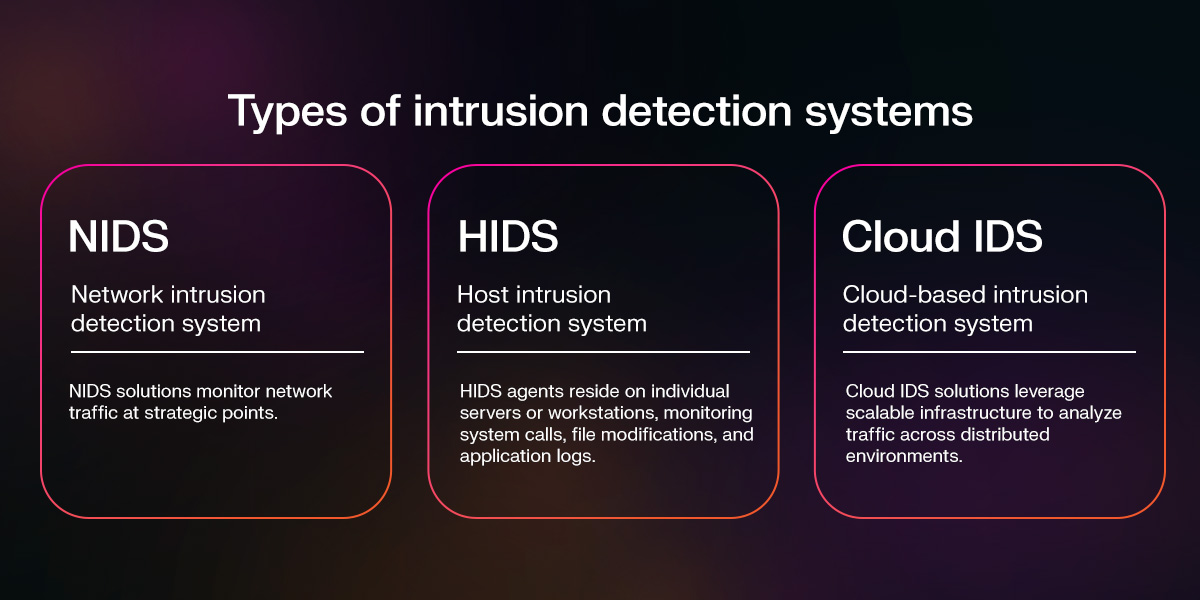What is Intrusion Detection System?
A deeper look at intrusion detection systems and their role in cybersecurity
Intrusions range from external threat actors attempting network penetration to insider threats misusing legitimate credentials for data exfiltration.
IDSs operate on core monitoring principles that involve:
- Continuous traffic analysis
- Pattern recognition
- Alert generation
These systems inspect network packets, system logs, and file integrity to identify anomalies or known attack signatures. The monitoring function captures and analyzes data flows across designated network segments, while the analysis engine compares observed patterns against predetermined rules or behavioral baselines.
Unlike firewalls that actively block traffic based on predefined rules, IDSs function as passive observers that generate alerts without intervening in network operations. While antivirus solutions focus on endpoint-specific threats through file scanning and process monitoring, IDSs provide broader visibility across the network infrastructure. Security teams often deploy these technologies in complementary configurations, with firewalls providing perimeter defense, IDSs offering detection capabilities, and antivirus software protecting individual endpoints.
History of intrusion detection systems
The evolution of intrusion detection began in the 1980s with the establishment of statistical anomaly detection as a viable security approach. Throughout the 1990s, commercial IDS products emerged, employing signature-based detection methods that compared network traffic against databases of known attack patterns.
The early 2000s witnessed significant advancement as organizations recognized the limitations of purely signature-based approaches. Vendors introduced hybrid systems that combined signature detection with anomaly-based methods, trying to identify unknown threats. However, these systems struggled with high false positive rates and required extensive tuning to minimize alert fatigue among security teams.
Network complexity and the increase in encrypted traffic have challenged the effectiveness of IDSs. The rise of cloud computing, remote work, and sophisticated attack techniques like living off the land strategies exposed fundamental limitations. These challenges catalyzed the development of more advanced solutions incorporating machine learning and behavioral analytics.
Types of intrusion detection systems
Organizations deploy various IDS architectures depending on infrastructure requirements, security objectives, and operational constraints.

Network intrusion detection system (NIDS)
NIDS solutions monitor network traffic at strategic points, typically behind firewalls or at network segment boundaries. These systems analyze packet headers and payloads to identify suspicious patterns or known attack signatures. NIDS deployment provides broad visibility but struggles with encrypted traffic and high-speed networks that can overwhelm processing capabilities.
Host intrusion detection system (HIDS)
HIDS agents reside on individual servers or workstations, monitoring system calls, file modifications, and application logs. These systems excel at detecting insider threats and identifying compromise indicators on critical assets. However, HIDS requires installation and maintenance across multiple endpoints, creating management overhead and potential performance impacts on monitored systems.
Cloud-based intrusion detection system (Cloud IDS)
Cloud IDS solutions leverage scalable infrastructure to analyze traffic across distributed environments. These systems address traditional deployment challenges by eliminating hardware requirements and providing centralized management. Cloud-based approaches particularly benefit organizations with hybrid infrastructures, though they introduce dependencies on internet connectivity and raise data sovereignty concerns for regulated industries.
Key features of IDS
Intrusion detection system tools incorporate various detection and analysis capabilities to identify potential security incidents:
- Signature-based detection: This primary detection method compares observed traffic against databases containing thousands of attack signatures. Each signature is a specific pattern associated with known exploits, malware communications, or attack techniques. Signature matching cannot detect zero-day exploits or custom attack tools lacking corresponding signatures.
- Anomaly-based detection: Statistical analysis establishes baselines of normal network behavior, flagging deviations that might indicate malicious activity. These systems monitor metrics including traffic volumes, protocol distributions, and connection patterns. However, defining “normal” is challenging in dynamic environments, leading to excessive false positives and high instances of alert fatigue.
- Passive monitoring and alerting: IDSs observe network traffic without blocking or modifying packets, generating alerts for security teams to investigate. Alert volumes often overwhelm security operations centers, particularly when false positives dominate notification streams.
- Pattern matching: IDSs identify attack sequences across multiple packets or events. However, these detection methods struggle with encrypted traffic, which now comprises over 90% of internet traffic according to Google's Transparency Report. Without deep packet inspection capabilities, traditional IDSs operate with reduced visibility in modern encrypted environments.
The deployment model impacts IDS capabilities and operational requirements. Agent-based deployments require software installation on each monitored system, providing detailed visibility into host activities but creating management overhead. These implementations enable sophisticated behavioral analysis but may impact system performance and require compatibility testing across diverse platforms.
Some intrusion detection systems are agentless. Agentless deployments monitor traffic through centralized sensors without endpoint software requirements. This approach simplifies implementation and eliminates endpoint performance concerns, which is valuable in cloud environments where agent installation might violate service agreements.
What are practical alternatives to IDSs?
Despite their widespread deployment, traditional IDS solutions face critical limitations that increasingly undermine their effectiveness against modern threats:
- Inability to detect novel attacks
- Excessive false positives
- Limited visibility into encrypted traffic
- Passive response limitation
- Lack of contextual understanding
- Resource-intensive management
Today's adversaries employ advanced techniques that bypass traditional, signature-based detection methods, leveraging zero-day exploits and polymorphic malware to render conventional IDS solutions inadequate. This shift necessitates exploring advanced detection methodologies such as:
Intrusion prevention system (IPS)

IPS technology extends IDS functionality by actively blocking detected threats. These solutions provide immediate threat mitigation without human intervention, reducing the window of opportunity for attackers. IPS platforms incorporate reputation filtering, sandboxing, and SSL inspection to enhance detection accuracy.
However, false positives in IPS deployments cause service disruptions, requiring careful tuning to balance security and availability. Organizations must maintain bypass mechanisms to prevent IPS failures from causing network outages.
Security information and event management (SIEM)
SIEM platforms represent the core of many security approaches, aggregating and analyzing logs from across an organization's digital environment and applications. As such, they provide centralized visibility and correlation, with advanced analytics to identify attack patterns spanning multiple systems and time frames that individual tools miss. SIEM solutions incorporate user and entity behavior analytics (UEBA) to detect insider threats and compromised credentials and support compliance requirements through comprehensive audit trails and automated reporting.
SIEM deployments are valuable, but they require significant investment in licensing, infrastructure, and skilled personnel for effective operation.
Endpoint detection and response (EDR)
EDR solutions focus on endpoint threats, providing detailed forensics and automated containment capabilities. These tools record comprehensive endpoint telemetry, enabling retroactive threat hunting and incident investigation. Plus, built-in machine learning algorithms identify malicious behaviors regardless of whether traditional signatures exist. EDR platforms enable surgical threat remediation without reimagining systems, reducing recovery time and operational impact.
A limitation, though, is that EDR lacks the network-wide visibility essential for detecting lateral movement, data staging, and exfiltration activities.
Network detection and response (NDR)
NDR solutions establish dynamic baselines of normal network behavior for each organization, identifying subtle deviations that indicate potential threats. Through behavioral analysis, they detect suspicious activities regardless of whether corresponding signatures exist. Machine learning algorithms automatically correlate multiple weak signals into high-confidence threat alerts while filtering false positives.
NDR provides comprehensive visibility across all network communications, including encrypted traffic analysis through metadata examination and JA3 fingerprinting. These platforms investigate alerts automatically, constructing attack narratives that explain threat progression and impact. This context enables security teams to prioritize response efforts.
NDR solutions also provide automated response capabilities, containing threats through integration with firewalls, switches, and other infrastructure. NDR's AI-powered machine learning eliminates constant tuning requirements, adapting automatically to infrastructure changes and evolving business operations.
Enhance your network security with Darktrace
While intrusion detection systems established essential monitoring capabilities decades ago, their signature-based approaches and passive nature leave organizations exposed to modern threats. NDR technologies address the fundamental limitations of IDS through behavioral analytics and machine learning.
Darktrace / NETWORK™ delivers the most advanced NDR capabilities, powered by Self-Learning AI that understands your unique environment without relying on outdated signatures or manual rules. Our multi-layered AI platform learns what constitutes normal behavior for an organization, identifying subtle anomalies that indicate genuine threats and filtering the false positives. Explore some of our Cyber AI insights to learn more about these capabilities.

























